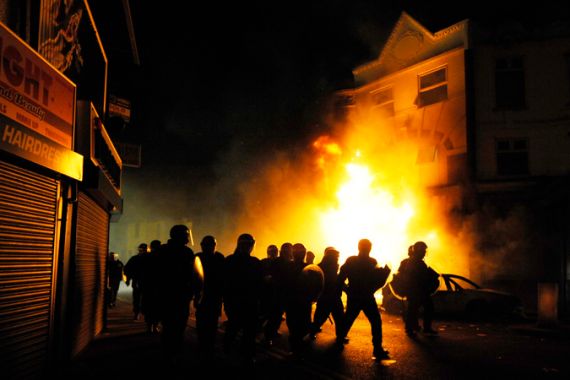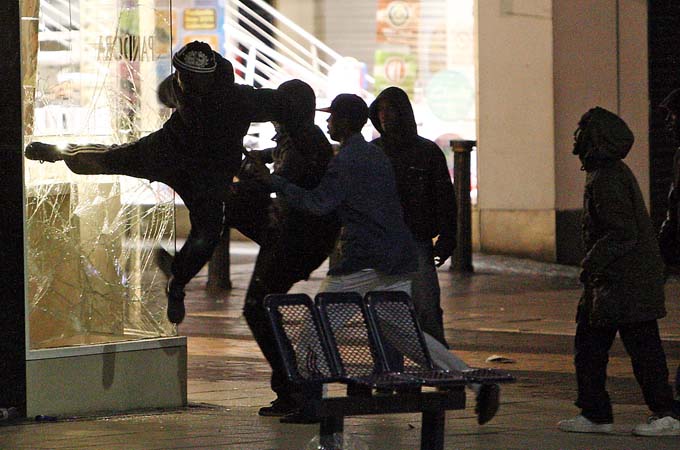Londoners: Rioting through the ages
Although Britain has a long history of civil uprisings, the recent riots lack a clear political or moral consciousness.

 |
| British history suggests that taking a harsh response to riots could only exacerbate the problem [EPA] |
Back in the summer of 2010, as Chancellor George Osborne announced a swingeing package of public sector cuts, many journalists wondered why Britain, unlike other European countries, appeared phlegmatic about such severe austerity measures. Was this is simply an example of the British “stiff-upper lip”, that stoical Britons don”t “do” civil disobedience?
These are questions that the past year has rendered ridiculous. London has seen serious riots break out at student demonstrations in November and December 2010, while peaceful mass demonstration organised by the Trades Union Congress in March of this year descended into violence as groups of demonstrators occupying Trafalgar Square clashed with police.
The looting and arson that has scarred London and now other English cities represents the most frightening apparent manifestation of this public discontent. Yet, unlike the student riots or mass demonstrations, there are seemingly few precedents in British history for the kinds of violent disturbances the country has witnessed in the past few days. Indeed, it is the lack of a clear context (social, historical or otherwise) that makes them so terrifying.
Rebels without a cause?
Britain is certainly no stranger to serious rioting or civil disturbance. Many of the areas of England affected by looting, such as Toxteth in Liverpool and Brixton in South London, have a history of unrest. There appear to be parallels, too, in the way that the death of Mark Duggan has led to rioting in Tottenham, just as the death of Cynthia Jarrett provoked the Broadwater Farm riots in the same borough of Haringey in 1985.
But in the case of the Broadwater Farm riots, and those in Brixton and Toxteth in 1981, these disturbances were clearly prompted by allegations of police racism and brutality. These accusations were partially upheld by official investigations into these riots, such as the Scarman report of 1981. The 1999 Macpherson Report into the Metropolitan Police’s handling of the investigation of the murder of Stephen Lawrence, with its frank indictment of the force as “institutionally racist”, ultimately led to significant changes in the conduct of policing in London. Most of those who have discussed police/community relations in the light the rioting in Tottenham, Hackney and Brixton acknowledge that there have been considerable improvements.
Indeed, whatever negative views some Londoners may still have of the Met, what is striking is the degree of consensus among commentators that Mark Duggan’s death has been used as a little more than a pretext by those involved in this weekend’s destruction.
Damage to property has, of course, been a feature of many violent protests in Britain’s past. The Suffragettes famously targeted gentleman’s outfitters as symbols of patriarchal oppression. More recently, anti-capitalist protesters have often targeted major global brands such as McDonalds and Starbucks.
But the youths involved in this August’s unrest have hit local independent shops and chain stores alike – the only discrimination evident is the value placed on particular goods. It has been the accoutrements of urban youth – box-fresh trainers, smart phones, clothes – which have been most readily plundered. The only ideology on display, if it can even be called that, is that of the kindergarten: “Finders keepers”.
If this were merely run-of-the-mill shoplifting, the nation would not be in a state of near-panic, but gangs of looters have now hit cities across England. Here analysts have pointed to similarities with recent protest movements, most notably those of the “Arab Spring”, which have harnessed social media to coordinate and mobilise support. But even if gangs have been organised through BlackBerry Messenger (BBM) – significantly, a very closed form of social networking – the comparison is more insulting than helpful. These are not brave campaigners for democracy and Reeve’s Corner, Croyden, is certainly not Britain’s Tahrir Square. The youths emptying sporting goods stores across the land, unlike previous generations of British rebels, have no manifesto. As a result, there are no demands that authorities in Britain can easily meet in order to pacify them. Yet, even as apolitical as they are, the looters pose a very serious threat to the British government.
Who governs?
In the English civil war of 1642-6, mob violence played an important role in forcing the king, Charles I, to abandon his capital city. The same pattern unfolded during the “Glorious Revolution” of 1688, as anti-Catholic rioting led Charles’ son, James II, to flee.
Civil disorder, as recent history demonstrates, can also fatally undermine the credibility of an elected government. In February 1974, in the wake of crippling strikes by the National Union of Mine Workers, the debilitated administration of Conservative Prime Minister Edward Heath called an election, using the slogan: “Who Governs Britain?” Whoever did govern Britain, it was not Edward Heath: the British electorate delivered the first hung Parliament since 1929 and serious industrial action plagued the country for a decade more, playing no small part in the defeat of Labour Prime Minister James Callaghan in 1979.
Eleven years later, civil unrest once again cost a prime minister their job. The poll tax riots of March 1990, which began as a peaceful demonstration against the Thatcher government’s hated new tax, the Community Charge, turned into a riot in Trafalgar Square, leaving more than a hundred people injured and resulted in the arrest of 339 people. Though the violence was condemned by both government and activists alike, the strength of opposition to the community charge led to its abandonment and fundamentally weakened Margaret Thatcher’s authority: the “Iron Lady” who “wasn’t for turning” had been cowed into a humiliating U-turn.
The current PM, David Cameron, has now chosen to return home early from holiday in Tuscany to take control of the developing crisis. Cameron clearly understands that a weak response to events could ultimately cost him his job, as it has some of his predecessors. The difficulty is that past precedent indicates that a hard-line response could be equally as disastrous.
From ‘hug a hoodie’ to ‘hang a hoodie’
The public anger provoked by the scenes of looting and violence that have played out over August 6-8 is evident in calls for the British police to employ tougher tactics – water cannon and baton rounds – and in demands for military intervention.
As scenes of feral, masked youth plundering at will fill the nation’s television screens, Cameron’s 2006 injunction to supporters to “hug a hoodie”, delivered as he attempted to re-brand the Tories as “compassionate Conservatives”, now appears embarrassingly naive. For the moment, however, Cameron has resisted calls for more extreme measures, looking instead to flood London’s streets with enough officers to suppress any disturbance.
History suggests that this is a sensible response. Leaving aside the fact that the present British armed forces are themselves stretched to breaking point by international commitments and the impact of government cuts, the history of military intervention in quelling civil disorder is not a happy one.
Before the emergence of organised local and national police forces in the nineteenth century, the army was the only significant weapon that the British government had to suppress riot and insurrection. The last time that London experienced successive nights of lawlessness on a scale comparable with present unrest, during the anti-Catholic Gordon Riots of June 2-9, 1780, George III’s decision to send in the troops, while ending the unrest, resulted in the death of more than two hundred people.
It was the use of troops to disperse a crowd of peaceful pro-democracy demonstrators in St Peter’s Fields, Manchester, on August 16, 1819, that led to the infamous “Peterloo Massacre”, in which fifteen people died and a further four hundred were injured. The much more recent, but equally bitter experience of British troops patrolling the streets of Northern Ireland, offers a further reminder that soldiers are not policemen and that their presence will often inflame rather than pacify tensions.
The revival of tactics such as the use of “sus” laws – broad-ranging stop and search powers – by police is rumoured to have already triggered more violence in Hackney. It is entirely possible that the deployment of water cannon and rubber bullets might do the same – especially were someone to be seriously injured through the use of these devices. But if the temptation to adopt an overly aggressive stance towards the looters should be resisted, the question of what to do instead offers no easy answers.
Many liberal commentators have suggested that the government’s own austerity measures have produced these disturbances, but if that is an explanation, it is only a partial one. The impact of these cuts is really only just being felt. Cutting further may well provoke more rioting – but the uncomfortable truth is that the events of the past few days have been the result of decades, not months of neglect, deprivation and widening social inequality. It may well take decades more to address these inequalities.
Yet the tangled causes of urban decay in this country must be unravelled. Otherwise, Britain may be faced with a social menace that cannot be stopped, because this rebellion, unlike past insurrections, has no political or moral consciousness, only an indiscriminate urge to consume and destroy.
Dr Ted Vallance is Reader in history at Roehampton University and the author of A Radical History of Britain (Abacus, 2010).
The views expressed in this article are the author’s own and do not necessarily reflect Al Jazeera’s editorial policy.
